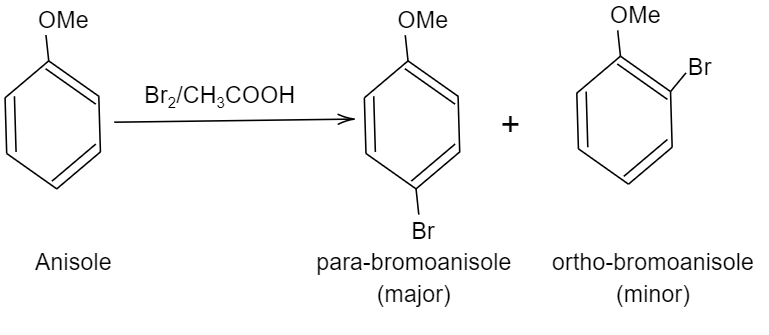
How does anisole react with bromine in ethanoic acid? Write the chemical equation for the reaction.
Answer
569.4k+ views
Hint: You should know that; anisole is an electron withdrawing group. It undergoes electrophilic substitution. The halogenation will take place only at the ortho and para positions for anisole and the meta position is not included during this reaction.
Complete step by step solution:
Anisole is an organic compound, which is also known by methoxybenzene. It has a chemical formula ${{C}_{6}}{{H}_{5}}OC{{H}_{3}}$.
The methoxy group present in anisole acts as an electron donating group and it will donate its electron density of the oxygen atom to the benzene ring and thus, the electron density on the benzene ring will increase. Further, this will undergo electrophilic aromatic substitution, resulting in halogenation.
We should know that the methoxy group present in anisole is an ortho, para directing, thus it makes anisole ortho-para directing in nature. So, while reacting, the attacking group will attach to the ortho or para position with respect to the methoxy group in the ring.
Now, coming to ethanoic acid. As we know it is called acetic acid, which acts as a polar solvent for dissolving anisole.
So, we can write the chemical reaction of bromination of anisole as follows:

We can see, two products are formed i.e. para-bromoanisole (also written as $1-bromo-2-methoxybenzene$) and the other product is ortho-bromoanisole or $1-bromo-4-methoxybenzene$.
Note: Among these two products formed, para-bromoanisole is the major product and its yield will be around $90%$, ortho product formed is considered as the minor product due to the presence of steric hindrance in the ortho position (bulky methoxy group is present in the ortho group of the benzene ring).
Complete step by step solution:
Anisole is an organic compound, which is also known by methoxybenzene. It has a chemical formula ${{C}_{6}}{{H}_{5}}OC{{H}_{3}}$.
The methoxy group present in anisole acts as an electron donating group and it will donate its electron density of the oxygen atom to the benzene ring and thus, the electron density on the benzene ring will increase. Further, this will undergo electrophilic aromatic substitution, resulting in halogenation.
We should know that the methoxy group present in anisole is an ortho, para directing, thus it makes anisole ortho-para directing in nature. So, while reacting, the attacking group will attach to the ortho or para position with respect to the methoxy group in the ring.
Now, coming to ethanoic acid. As we know it is called acetic acid, which acts as a polar solvent for dissolving anisole.
So, we can write the chemical reaction of bromination of anisole as follows:

We can see, two products are formed i.e. para-bromoanisole (also written as $1-bromo-2-methoxybenzene$) and the other product is ortho-bromoanisole or $1-bromo-4-methoxybenzene$.
Note: Among these two products formed, para-bromoanisole is the major product and its yield will be around $90%$, ortho product formed is considered as the minor product due to the presence of steric hindrance in the ortho position (bulky methoxy group is present in the ortho group of the benzene ring).
Recently Updated Pages
A man running at a speed 5 ms is viewed in the side class 12 physics CBSE

State and explain Hardy Weinbergs Principle class 12 biology CBSE

Which of the following statements is wrong a Amnion class 12 biology CBSE

Two Planoconcave lenses 1 and 2 of glass of refractive class 12 physics CBSE

The compound 2 methyl 2 butene on reaction with NaIO4 class 12 chemistry CBSE

Bacterial cell wall is made up of A Cellulose B Hemicellulose class 12 biology CBSE

Trending doubts
What are the major means of transport Explain each class 12 social science CBSE

Which are the Top 10 Largest Countries of the World?

Draw a labelled sketch of the human eye class 12 physics CBSE

Explain sex determination in humans with line diag class 12 biology CBSE

Give 10 examples of unisexual and bisexual flowers

State the principle of an ac generator and explain class 12 physics CBSE




